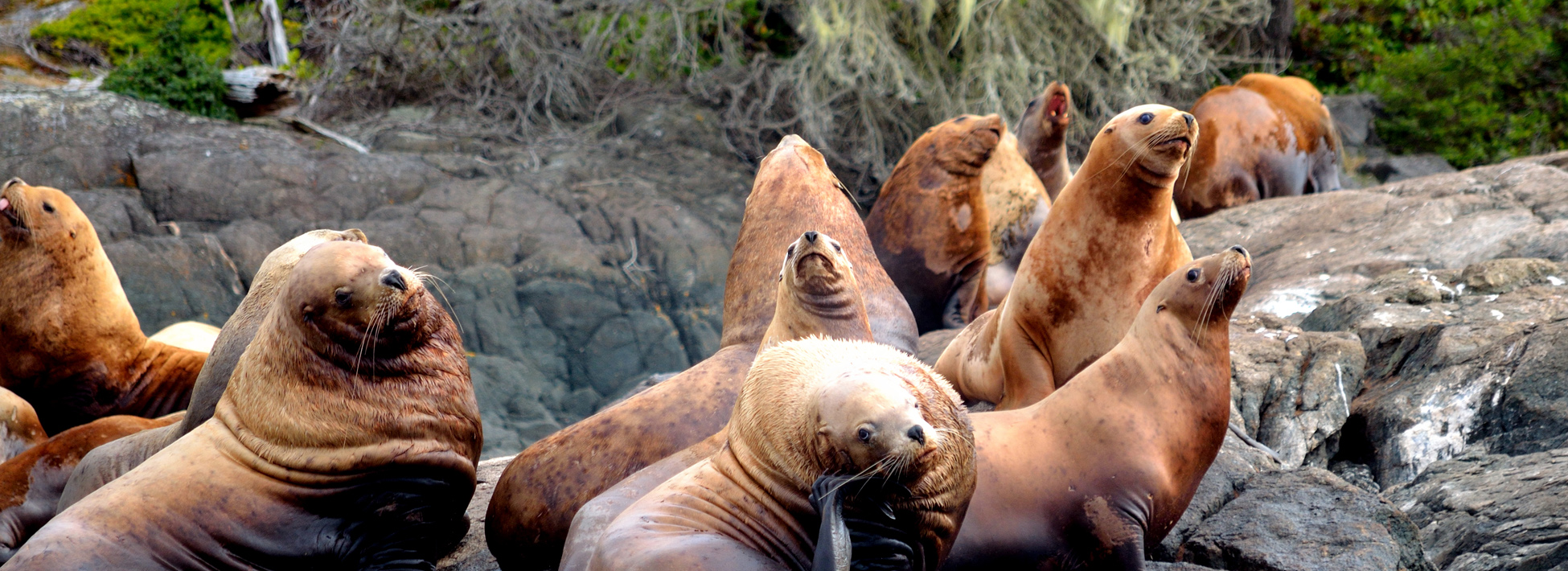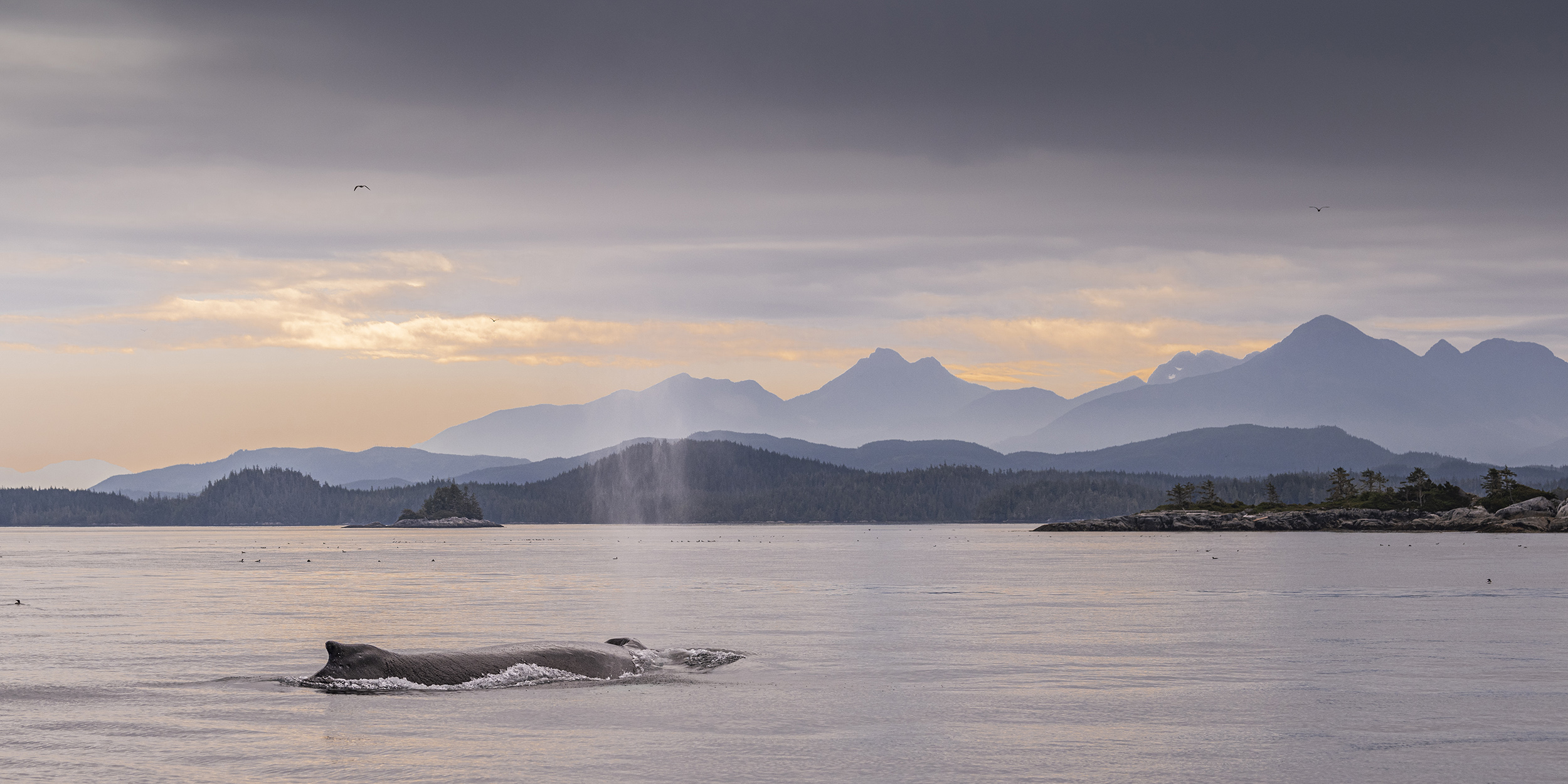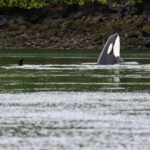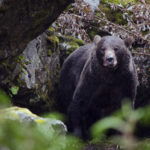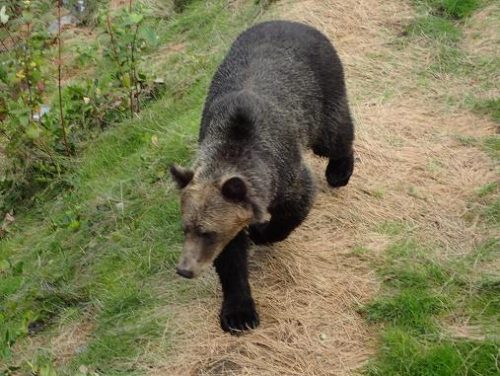 We had moved to a different viewing stand for the last twenty minutes for our viewing time for a different perspective of the many grizzly bears we were watching. It was interesting as this grizzly bear started walking down the causeway toward our new location. It was a cause for much photo taking as it was a chance for another good close up which only got better……
We had moved to a different viewing stand for the last twenty minutes for our viewing time for a different perspective of the many grizzly bears we were watching. It was interesting as this grizzly bear started walking down the causeway toward our new location. It was a cause for much photo taking as it was a chance for another good close up which only got better……
Grizzly Bear and Wildlife Viewing Blog: Monthly Archives: January 2017
Extra Day at Grizzly Bear Lodge 2 of 2
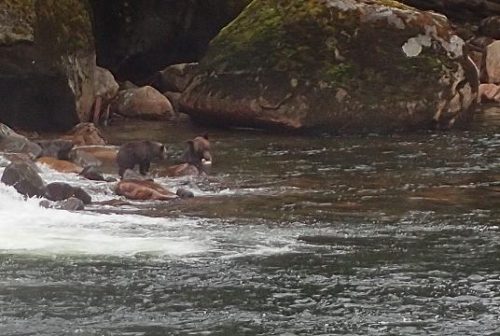 This mother grizzly with the salmon and her cub are about 50 meters (yards) across the river acting natural – fishing. The guests most often comment that this experience is much different than viewing grizzlies on Knight Inlet’s Glendale River the location of our primary grizzly viewing. First is that you are not in a skiff on the river or a viewing stand overlooking the spawning channel. Your are sitting across a river from a grizzly and if it choose could cross the river. Second there is Rick who has spent close to thirty years with these bears. They know his voice and respond in a calm manner when they hear Rick talking to them. If they are walking up river to where you are sitting Rick will stand and start talking as we back off to another location. The bears do not turn and run rather they continue toward you to complete their task and you get to watch them fish.
This mother grizzly with the salmon and her cub are about 50 meters (yards) across the river acting natural – fishing. The guests most often comment that this experience is much different than viewing grizzlies on Knight Inlet’s Glendale River the location of our primary grizzly viewing. First is that you are not in a skiff on the river or a viewing stand overlooking the spawning channel. Your are sitting across a river from a grizzly and if it choose could cross the river. Second there is Rick who has spent close to thirty years with these bears. They know his voice and respond in a calm manner when they hear Rick talking to them. If they are walking up river to where you are sitting Rick will stand and start talking as we back off to another location. The bears do not turn and run rather they continue toward you to complete their task and you get to watch them fish.
Extra Day at Grizzly Bear Lodge 1 of 2
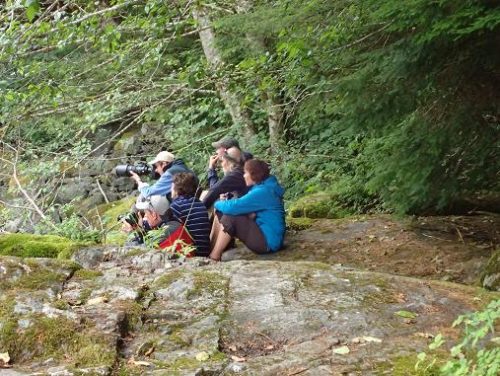 On the extra day in camp we spend the day on a river located on the BC mainland.After crossing Knight Inlet we travel through Thompson Sound to the Kakweikan River and spend the day with Trapper Rick. We travel via old overgrown logging roads to Rick’s cabin which is about two kilometres (miles) from the mouth of the river. In this photo Rick and four guests are sitting near the falls which is a natural fishing area for grizzlies. Not hard to find Rick in this photo and tomorrow’s post will show what has their interest….
On the extra day in camp we spend the day on a river located on the BC mainland.After crossing Knight Inlet we travel through Thompson Sound to the Kakweikan River and spend the day with Trapper Rick. We travel via old overgrown logging roads to Rick’s cabin which is about two kilometres (miles) from the mouth of the river. In this photo Rick and four guests are sitting near the falls which is a natural fishing area for grizzlies. Not hard to find Rick in this photo and tomorrow’s post will show what has their interest….
Orca Behaviour Pt2
As mentioned yesterday the behaviour of the orca varies day to day and is highly advanced. This whale is “spy hopping”. What the whale is basically doing is having a look at what is happening above the water line. Orca have advanced echolocation “sonar” abilities, which allows them to detect objects and animals underwater with pinpoint accuracy. They also like to check out what is happing above them as this orca is demonstrating.
Orca Behaviour Pt1
Grizzly Bear “Roy”
Roy is a male Grizzly Bear that we have commonly been seeing on our river trips. It is very rewarding to recognize certain bears and watch their behaviour over a season, or several seasons for that matter. Roy got his fair share of salmon and was looking fat and healthy by the end of the season. All set for a good six months of hibernation.
Orca Resting Line
These Orca are resting in the waters of Johnstone Strait. Whales are voluntary breathers, which means unlike us they have to think about every breathe that they take. When whales rest they shut down half of their brain and close the opposite eye. They reverse this process, so that both sides of their body is able to rest. This lets the animal rest, but also breathe and watch for danger.
Grizzly Mother Sharing?
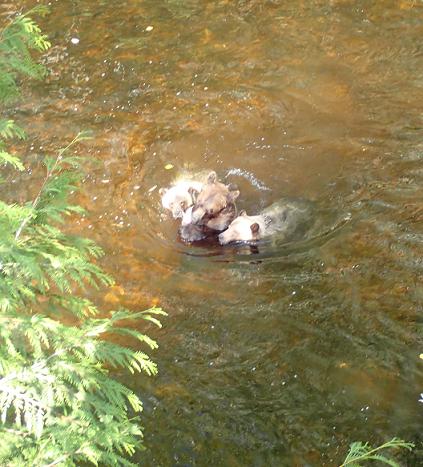 This photo also directly below the viewing platform shows a mother grizzly bear NOT wanting to share a salmon with her first year cubs. The number one priority of a grizzly with first year cubs is her own health. If she does not have sufficient body fat she will not be able to nurse and this reduces the survival rate. Once that issue has been achieved the sharing will start and every one will be happy (especially the guest I had who thought this was not a very good mother).
This photo also directly below the viewing platform shows a mother grizzly bear NOT wanting to share a salmon with her first year cubs. The number one priority of a grizzly with first year cubs is her own health. If she does not have sufficient body fat she will not be able to nurse and this reduces the survival rate. Once that issue has been achieved the sharing will start and every one will be happy (especially the guest I had who thought this was not a very good mother).
BEST GUEST BLOG
Please.
This is a great site to visit to get a “guest eye view” of a trip to our lodge. Be sure that you do the whole five days that Rob has set up for his trip.
Click on this link
http://www.masey.com.au/2010/08/dream-grizzly-trip-day-one/
Also: -if you search “You Tube” using the keyword SAILCONE you can view some videos from and about the lodge.
-and on Facebook at Grizzly Bear Lodge and Safari
To view a map of the lodge’s area and the location of each day’s itinerary”
Look to the left and scroll the sidebars to “Pages” and select “Google Map of Grizzly Bear Lodge Itinerary”
It is possible to navigate the map using the arrows in the upper left corner and to zoom using the + or – signs as well as changing to a satellite view in the upper right corner of the map.
How Many Grizzly Bear Cubs 1 of 2
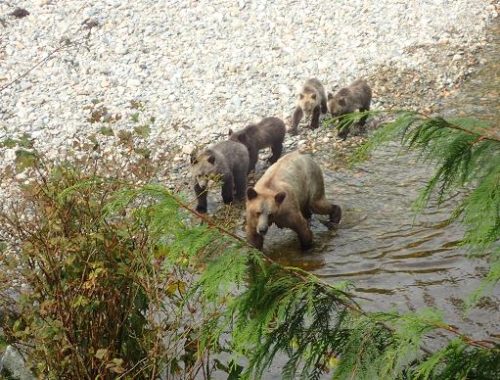 Yes there are four first year cubs and this is one of two sets we have seen in our viewing area this year. Twins and triplets are common but four is still rare. After mating, the female may be pregnant, but that does not mean she will give birth to cubs. Bears have developed a process called delayed implantation. The fertilized egg develops into a small embryo called a blastocyst. This is where the interesting stuff begins. After this brief period of development, of the fertilized egg suddenly stops growing and simply floats freely in the uterus for several months. If a sow is in peak condition when she heads into her winter den, the embryo implants in the uterus and begin to develop. She’ll wake up during January or February to give birth. Healthy bears tend to have multiple births so this indicated we have a very healthy population of grizzlies.
Yes there are four first year cubs and this is one of two sets we have seen in our viewing area this year. Twins and triplets are common but four is still rare. After mating, the female may be pregnant, but that does not mean she will give birth to cubs. Bears have developed a process called delayed implantation. The fertilized egg develops into a small embryo called a blastocyst. This is where the interesting stuff begins. After this brief period of development, of the fertilized egg suddenly stops growing and simply floats freely in the uterus for several months. If a sow is in peak condition when she heads into her winter den, the embryo implants in the uterus and begin to develop. She’ll wake up during January or February to give birth. Healthy bears tend to have multiple births so this indicated we have a very healthy population of grizzlies.
